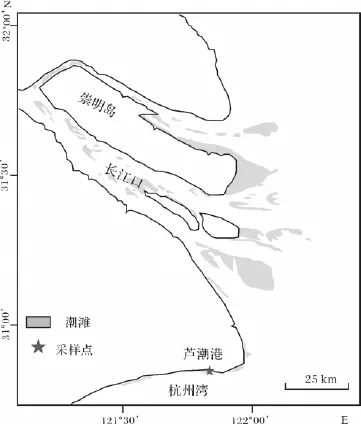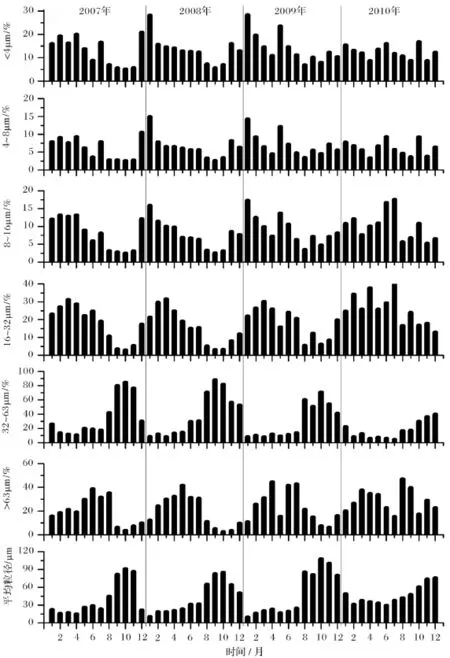杭州湾北岸芦潮港潮滩沉积物磁性特征的年际变化及其粒度控制①
2012-12-13张卫国杨世伦董辰寅俞立中
刘 莹 张卫国 杨世伦 罗 艺 董辰寅 俞立中
(华东师范大学河口海岸学国家重点实验室 上海 200062)
杭州湾北岸芦潮港潮滩沉积物磁性特征的年际变化及其粒度控制①
刘 莹 张卫国 杨世伦 罗 艺 董辰寅 俞立中
(华东师范大学河口海岸学国家重点实验室 上海 200062)
对杭州湾北岸芦潮港潮滩2007-2010年固定点沉积物进行了逐月的磁性测量和粒度分析,探讨了磁性特征的月际、年际变化及其与粒度的关系。结果显示,2007-2009年,芦潮港潮滩沉积物的磁性特征呈现出相似的季节性变化特征,磁性参数χ、χARM、SIRM以及比值χARM/SIRM总体上在12月次年7至月表现为高值,8-11月为低值,S-300变化趋势与之相反。粒度分析显示,每年12月至次年7月沉积物粒度总体较细,8-11月较粗,这说明潮滩较细沉积物中含有较多的亚铁磁性矿物,与已报道的2004-2005年研究结果相似。相比前三年,2010年1-7月及12月沉积物磁性矿物含量相对下降,8-11月份磁性矿物含量相对上升,导致2010年磁性参数月际变化幅度减小。同时,2010年沉积物粒度月际变化特征也发生了改变,即1-7月及12月沉积物粒度变粗,8-11月沉积物变细。相关分析表明,磁性参数与粒度之间的关系在2007-2010年中没有发生明显的变化,说明2010年沉积物粒度月际变化模式的改变是磁性特征月际变化改变的主导因素。尽管如此,长江流域来沙下降对河口潮滩沉积物物源的可能影响,仍需予以长期关注。
潮滩 磁性特征 粒度 月际变化 年际变化
河口潮滩提供了海岸防护、生物栖息地、水质净化等多种功能,其发育与潮流、风浪、泥沙供应、海平面变化、植被、周边地形、海岸工程等多种因素影响相关,存在不同周期的冲淤变化[1~7]。在全球气候变化和强势人类活动的背景下,潮滩的动态变化愈益剧烈,并影响到潮滩各种功能作用的发挥[8]。近年来,随着长江入海泥沙剧减,其对河口潮滩发育的影响,引起了广泛的关注[9]。杭州湾北岸潮滩发育于强潮海湾,其泥沙主要源于长江入海泥沙向杭州湾的扩散[10]。在长江入海泥沙剧减的背景下[11],杭州湾北岸潮滩沉积物的泥沙来源有无变化,是一个值得探讨的问题。磁性矿物(主要为铁的氧化物和硫化物)是沉积物中普遍存在的组分,磁性矿物的类型、含量和晶粒大小等特征,可以反映沉积物的物源变化,被广泛用于河流悬沙、大气悬浮颗粒物、沉积物等的物源追踪[12,13]。我们曾对2004年9月至2005年8月期间芦潮港潮滩固定点(图1)的沉积物进行过为期一年的采样和分析,发现沉积物的粒度和磁性特征存在显著的季节变化,总体上,12月底至次年5月上旬为潮滩淤积时期,沉积物粒度较细,磁性矿物含量较高,且磁性颗粒较细[14]。基于上述研究,本文拟通过2007-2010年期间的芦潮港同一站点表层沉积物磁性特征的分析,拟探讨长江流域来沙减少背景下,芦潮港沉积物组成的年际变化及其环境控制因子。
1 研究区概况
芦潮港位于长江口与杭州湾交汇地带的南汇南滩,其所在水域属于非正规浅海半日潮,多年平均潮差3.38 m,大潮潮差>4 m,属强潮海岸[2]。潮流基本为东西向往复流,主流向与沿岸等深线大致平行,大潮涨潮平均流速1.1 m/s,落潮平均流速0.91 m/ s,波浪特别是东南向波浪作用较强[7]。南汇南滩邻近水域悬沙浓度一般冬季高于夏季[15]。受风浪、潮汐、长江入海水沙通量等因素的综合影响,取样点所在的潮滩地形监测断面总体上呈现夏秋冲刷(一般7-12月)、冬春淤积(一般1-6月)态势[16]。从年际变化的角度,由长江口河槽主泓摆动引起经由南槽进入杭州湾的水沙发生变化,对芦潮港岸段的侵蚀、淤积有强烈影响,一般长江口南槽分水分沙增大时,芦潮港岸段发生淤积[6]。
2 样品采集与研究方法
芦潮港潮滩表层沉积物样品采集于2007年至2010年,每月大、小潮在中潮滩固定点30°50.9'N, 121°51.3'E)各取一个表层(<1 cm)沉积物样,取样时间为退潮后滩面出露时刻。采集的样品于低温下烘干(<40℃),除一部分样品进行粒度分析外,其余样品用研钵分散,以备磁性测量。使用 Bartington MS2双频磁化率仪测量低频(0.47 kHz)磁化率(χ),利用Dtech2000交变退磁仪(交变磁场峰值100mT,直流磁场0.04mT)产生非磁滞剩磁(ARM),并以Minispin旋转磁力仪测定(本文表达为其磁化率形式,即χARM)。随后利用MMPM10脉冲磁化仪依次获得样品在1T和-300mT磁场下的等温剩磁(IRM),并利用旋转磁力仪测定。本文中将1T磁场获得的IRM称为饱和等温剩磁(SIRM),并计算了退磁参数S-300=100 X(SIRM-IRM-300)/(2 XSIRM),以及比值参数χARM/SIRM。
χ和SIRM近似地指示样品中磁性矿物含量,与χ不同的是,SIRM不受顺磁性、抗磁性矿物的影响,主要反映亚铁磁性矿物(如磁铁矿)的含量[12]。χARM受到磁性矿物晶粒大小的显著影响,稳定单畴亚铁磁性矿物晶粒的χARM要显著高于超顺磁和多畴晶粒, χARM/SIRM常用于磁性矿物颗粒大小的指示,较低的比值则反映了较粗的磁性颗粒[17].-300反映样品中亚铁磁性矿物(如磁铁矿)与不完全反铁磁性矿物(如赤铁矿、针铁矿)的相对组成,它随着不完全反铁磁性矿物的比例增加而下降[18]。
粒度分析步骤如下:称取50 mg左右样品于50 ml烧杯中,加入5 ml 10%HCl,静置半小时,以去除碳酸盐,再加入5 ml 10%H2O2,并于电热板(100℃)上加热20分钟以去除有机质,冷却静置过夜。第二天吸除上层清液,用蒸馏水将样品清洗2~3次,加入10 ml 0.5%分散剂六偏磷酸钠(Na(PO3)6),30 min后放入超声波仪器中超声10 min,使颗粒分散充分,用库尔特激光粒度仪(Coulter LS-100Q)进行粒度分析。
3 结果与讨论
3.1 磁性特征月际和年际变化
在下文讨论时,每月沉积物的磁性和粒度数据为该月大、小潮四个样品的平均值。2007年至2009年,芦潮港潮滩沉积物磁性参数χ、χARM、SIRM以及χARM/SIRM年内呈相似变化趋势,12月至次年7月一般表现为高值,8-11月为低值;S-300变化趋势与之相反,高值出现在8-11月(图2)。这表明12月至次年7月沉积物中亚铁磁性矿物含量较高,且磁性颗粒较细,但亚铁磁性矿物所占比例较小,8-11月反之。这与邢云等人对同一地点2004年9月至2005年8月采集的沉积物磁性特征研究结果相符[14]。

图1 研究区域及采样点Fig.1 The study area with the sampling site
2010年,沉积物磁性特征月际变化较前三年有所不同。χ以及SIRM的高值主要出现在8-11月,而1-7月及12月要低于前三年的相应月份。χARM值较前三年相比,1-7及12月稍许下降,而8-11月的增加不如χ和SIRM显著(图2),因此χARM月际变化幅度减小,且8-11月期间亚铁磁性矿物含量的增加主要不是由于单畴亚铁磁性矿物颗粒的增加所致。χARM/SIRM作为指示亚铁磁性矿物颗粒大小的参数[18],月际变化幅度不大.-300相比前三年,则表现为1-7月及12月相对增加和8-11月相对下降,即1-7月及12月亚铁磁性矿物比例增加,而8-11月份亚铁磁性矿物比例下降,全年季节变化幅度不大。

图2 沉积物磁性特征的月际和年际变化(2007-2010年)Fig.2 Monthly and annual variations ofmagnetic properties for surface sediments sampled from 2007 to 2010
3.2 粒度特征月际和年际变化
2007至2009年,芦潮港潮滩沉积物粒度特征呈相似的月际变化,<4μm,4~8μm,8~16μm,16~ 32μm及>63μm粒级含量在每年12月至次年7月表现为高值,8~11月表现为低值,32~63μm粒级反之,平均粒径的值在12月至次年7月显著低于8 ~11月(图3)。这说明沉积物粒度在下半年粗化,与该地点2002-2005年期间的粒度研究结果相一致[14-15]。
相比前三年,2010年1-7月沉积物<4μm、4~ 8μm粒级含量总体下降,因而其月际变化差异变小。8~16μm、16~32μm以及32~63μm粒级变化趋势类似于前三年,但8~16μm和16~32μm粒级在8-11月的含量同比前三年有所增加,32~63μm粒级在8-11月的高值显著低于前三年同期。>63 μm粒级在1-7月变化趋势类似于前三年,但在8-12月含量有较大的增加。从平均粒径来看,相比前三年,2010年1-7月及12月沉积物粒度变粗,8-11月反之(图3)。

图3 沉积物粒度组成与平均粒径的月际和年际变化(2007-2010年)Fig.3 Monthly and annual variations changes in particle size for surface sediments sampled from 2007 to 2010
比较不同年份的粒度频率曲线可以发现,代表2010年粒度最粗的11月样品,150μm的峰值粒径含量明显低于2009年相同月的样品,但却在粒级25 μm左右出现一个次峰值。代表2010年粒度最细的6月份样品,相比2009年6月样品,其峰值粒径出现在较粗的40μm(图4),分选性变好。这也反映了2010年沉积物粒度在上半年较之前的年份发生粗化,下半年较之前的年份发生细化。

图4 2009年与2010年典型月份潮滩沉积物粒度频率分布曲线比较Fig.4 Comparison of particle size distribution curves of surface sediments sampled in the year of 2009 and 2010
3.3 磁性特征变化的粒度控制
潮滩表层沉积物磁性特征的变化主要受粒度和物源变化的影响[19~26]。已有长江口及杭州湾北岸潮滩沉积物磁性特征的研究表明,该区域沉积物磁性矿物颗粒主要富集在<32μm的粒级中,SIRM、χARM与<16μm粒级呈现显著的正相关关系[14,23]。将本次研究的四年样品以及邢云等研究的2004-2005年样品相比较,可见磁性参数SIRM、χARM与<16μm粒级显著相关的特点没有明显的改变(图5a,b)。磁化率χ与SIRM以及χARM的关系在这五年中也没有发生明显的变化(图5c,d)。从表1中也可以看出,磁性参数χ、χARM、SIRM以及χARM/SIRM与各粒级的相关性相似,基本上都是与<16μm粒级呈正相关,与> 63μm粒级呈负相关,而S-300与<16μm粒级呈负相关,与>63μm粒级呈正相关。从表1中可以看出,磁性参数χ、χARM、SIRM以及χARM/SIRM与<16μm粒级的相关性自2009年来有所减弱,2010年尤为显著。分析图5可以发现,这两年中部分沉积物样品明显偏离SIRM、χARM与<16μm的主流关系,因而导致相关系数的下降。上述结果表明,在研究区域,磁性矿物主要在<16μm粒级中富集,而>63μm粒级则起了稀释磁性矿物的作用。因此2010年不同月份磁性特征的变化,仍主要是粒度变化的结果。由于1-7月及12月中<8μm粒级含量下降,因而与磁性矿物含量有关的参数都相应下降;而8-11月由于<32 μm的中粉砂以下粒级含量的增加,磁性矿物含量相应增加。

图5 不同年份芦潮港潮滩沉积物χARM、SIRM与<16μm粒级含量和χ的关系Fig.5 Relationships betweenχARM,SIRM and the fraction of<16μm as well asχfor sediments sampled in different years

表1 不同年份沉积物χ、χARM、SIRM、S-300、χARM/SIRM与粒度组成的相关系数(n=48)Table1 Correlation coefficients betweenχ,χARM,SIRM,S-300,χARM/SIRM and particle size in different years(n=48) (a)
2004和2005年,长江大通站记录的长江输沙量分别为1.47和2.16亿吨/年,2007-2009年的长江输沙量分别为1.38、1.30、1.11亿吨/年[27,28]。尽管上述年份入海泥沙数量发生了变化,但磁性特征与粒度的关系以及磁性参数之间的关系并未有显著的变化,这说明入海泥沙数量并未导致芦潮港潮滩沉积物来源的显著改变。这是因为芦潮港泥沙来自长江入海泥沙向杭州湾的扩散,但进入杭州湾的泥沙,并不是直接来自大通的泥沙,而是长江入海泥沙与河口底质再悬浮的混合泥沙,因而芦潮港区域水体悬沙浓度要高于长江河口分汊顶点徐六泾悬沙浓度[15]。这一混合过程导致泥沙组成时间上有相对均一性,体现了河口泥沙组成的缓冲效应,沉积物组成还未得以明显地在磁性特征上加以表现。因此,2010年芦潮港沉积物粒度的月际变化仍是磁性月际变化的主导因素。
沉积物粒度变化是动力、泥沙与底质等相互作用的结果,包括潮流、风浪、地形等影响因素,近期在芦潮港区域还存在大量的人类活动,如滩涂围垦工程等,这些自然和人为因素的叠加,使得潮滩冲淤机制变得复杂,并表现为同一地点沉积物粒度组成的月际变化上。2010年芦潮港潮滩沉积物磁性特征和粒度的月际变化与前三年呈现了不同的现象,要了解这一变化内在的驱动因素,尚需加强多学科的监测和分析。此外,随着流域和河口强势的人类活动加强,以及流域泥沙的减少,其对河口潮滩沉积物物源的影响仍需加强关注,2010年磁性参数与粒度相关程度的下降,可能反映了沉积物物源变化的因素。泥沙来源是潮滩形成的物质基础,利用磁性特征追索潮滩沉积物物源,对深入了解潮滩现代沉积过程和机制具有积极作用,可为探讨潮滩对流域和河口环境变化的响应过程提供基础数据。鉴于磁性测量方法的简捷、非破坏性等特点,它特别适用于针对动态沉积环境开展的高时间分辨率研究。
4 结论
2007-2009年期间,杭州湾芦潮港潮滩沉积物的磁性特征呈现出相似的月际变化特征,磁性参数χ、χARM、SIRM以及比值χARM/SIRM在12月至次年7月表现为高值,8-11月为低值,S-300变化趋势与之相反。粒度分析结果显示这三年里,潮滩较细的沉积物中含有较多的亚铁磁性矿物。2010年沉积物磁性特征的月际变化与前三年存在很大的不同,但由于磁性参数与粒度的关系在2007-2010年中没有发生明显的变化,说明2010年沉积物粒度月际变化模式改变是磁性特征月际变化特征发生改变的主导因素。由于1-7月及12月中 <8μm粒级含量下降,因而与磁性矿物含量有关的参数都相应下降;而8-11月由于<32μm以下粒级含量的增加,磁性矿物含量相应增加,导致磁性特征的月际变化幅度减小。粒度虽然对研究区域磁性特征变化起着控制作用,但是自2009年来磁性特征与粒度的相关程度有所降低。
对于2010年沉积物粒度和磁性特征月际变化有别于前三年的现象,需要综合考虑潮汐、潮流、台风、来沙量以及人类工程等多因子作用的因素,因此需要加强长时间序列的水动力、气象、地形等因素的同步观测,以进行机制上的探讨。此外,对于长江流域来沙下降对杭州湾潮滩沉积物物源的影响,需要予以长期关注。
References)
1 邵虚生,严钦尚。上海潮坪沉积[J]。地理学报,1982,37(3): 241-249[Shao Xusheng,Yan Qinshang.Intertidal flat sediments in Shanghai coastal region[J].cta Geographica Sinica,1982,37(3): 241-249]
2 曹沛奎,董永发,严肃庄,等。杭州湾北岸高能潮滩的基本特征[J]。海洋与湖沼,1989,20(5):412-422[Cao Peikui,Dong Yongfa,Yan Suzhuang,et al.Basic characteristics of the tidal flat on the north coast of Hangzhou Bay[J].ceanologia et Limnologia Sinica, 1989,20(5):412-422]
3 陈卫跃。潮滩泥沙输移及沉积动力环境-以杭州湾北岸、长江口南岸部分潮滩为例[J]。海洋学报,1991,13(6):813-821[Chen Weiyue.Sediments transportation and depositional dynamic environment in tidal flat:A case study of north Hangzhou Bay and partof south Yangtze Estuary[J].cta Oceanologica Sinica,1991,13(6):813-821]
4 杨世伦。风浪在开敞潮滩短周期冲淤演变中的作用——以南汇东滩为例[J]。海洋科学,1991(2):59-63[Yang Shilun.Impact of wind driven wave on short-period erosion and deposition of tidal flat:a case study from Nanhui Nan Shoal of Shanghai[J].arine Sciences, 1991(2):59-63]
5 杨世伦。长江三角洲潮滩季节性冲淤循环的多因子分析[J]。地理学报,1997,52(2):123-129[Yang Shilun.Multi-factor analysis of the annually cyclic erosion-deposition of Yangtze delta tidal flat[J].cta Geographica Sinica,1997,52(2):123-129]
6 刘苍字,虞志英。杭州湾北岸的侵蚀/淤积波及其形成机制[J]。福建地理,2000,15(3):12-15[Liu Cangzi,Yu Zhiying.Erosion and depositwaves along the northern shore of the Hangzhou Bay[J].ujian Geography,2000,15(3):12-15]
7 向卫华,李九发,徐海根,等。上海市南汇南滩近期演变特征分析[J]。华东师范大学学报:自然科学版,2003,3:49-55[Xiang Weihua,Li Jiufa,Xu Haigen,etal.The characteristicsof topography change on Nanhui Nan Shoal of Shanghai[J].ournal of East China Normal University:Natural Science,2003,3:49-55]
8 李九发,戴志军,刘新成,等。长江河口南汇嘴潮滩圈围工程前后水沙运动和冲淤演变研究[J]。泥沙研究,2010,3:31-37[Li Jiufa,Dai Zhijun,Liu Xincheng,et al.Research on the movement of water and suspended sediment and sedimentation in Nanhui spit of the Yangtze Estuary before and after the construction of reclamation projects on the tidal flat[J].ournal of Sediment Research,2010,3:31-37]
9 Yang S L,Zhang J,Zhu J,et al.Impact of dams on Yangtze River sediment supply to the sea and delta wetland response[J].ournal of Geophysical Research,2005,110,F03006,doi:10.1029/ 2004JF000271
10 曹沛奎,谷国传,董永发,等。杭州湾泥沙运动的基本特征[C]∥陈吉余,王宝灿,虞志英,等。中国海岸发育过程和演变规律。上海:上海科学技术出版社,1989:108-117[Cao Peikui,Gu Guochuan,Dong Yongfa,etal.Basic characteristics of sediment transport in Hangzhou Bay[C]∥Chen Jiyu,Wang Baocan,Yu Zhiying,etal.Developments and Evolution of China's Coast.Shanghai:Shanghai Science and Technology Press,1989:108-117]
11 Yang S L,Li M,Liu Z,et al.Drastic decrease in sediment supply from the Yangtze River and its challenge to coastal wetland management[J].eophysical Research Letters,2006,33,L06408,doi: 10.1029/2005GL025507
12 Thompson R,Oldfield F.Environmental Magnetism[M].ondon: Allen and Unwin,1986:1-227
13 Verosub K L,Roberts A P.Environmentalmagnetism:past,present and future[J].ournal of Geophysical Research,1995,100B: 2175-2192
14 邢云,张卫国,杨世伦,等。潮滩表层沉积物磁性特征的季节性变化及其对沉积动力作用的响应:以杭州湾北岸为例[J]。沉积学报,2007,25(2):267-273[Xing Yun,Zhang Weiguo,Yang Shilun,et al.Seasonal changes inmagnetic properties of surficial tidal flat sediment and their response to sedimentation dynamics:a case study from the coast of the Hangzhou Bay[J].cta Sedimentologica Sinica,2007,25(2):267-273]
15 陈沈良,张国安,杨世伦,等。长江口水域悬沙浓度时空变化与泥沙再悬浮[J]。地理学报,2004,59(2):260-266[Chen Shenliang,Zhang Guoan,Yang Shilun,et al.Temporal and spatial changes of suspended sediment concentration and resuspension in Yangtze River Estuary and its adjacent waters[J].cta Geographica Sinica, 2004,59(2):260-266]
16 陈沈良,杨世伦,吴瑞明。杭州湾北岸潮滩沉积物粒度的时间变化及其沉积动力学意义[J]。海洋科学进展,2004,22(3):299-305[Chen Shenliang,Yang Shilun,Wu Ruiming.Temporal changes in tidal flat sediment grain size along the north bank of the Hangzhou Bay and their implication of sedimentation dynamics[J].dvances in Marine Science,2004,22(3):299-305]
17 Maher B A.Magnetic properties of some synthetic submicron magnetites[J].eophysical Journal,1988,94:83-96
18 Walden J,Oldfield F,Smith JP.EnvironmentalMagnetism:A Practical Guide[M].echnical Guide,No。6,Quaternary Research Association,London,1997
19 Razjigaeva N G,Naumova V V.Trace element composition of detrital magnetite from coastal sediments of northwestern Japan Sea for provenance study[J].ournal of Sedimentary Research,1992,62:802-809
20 Oldfeld F,Yu L Z.The infuence of particle size variations on the magnetic properties of sediments from the north-eastern Irish Sea[J].edimentology,1994,41:1093-1108
21 Lees JA,Pethick JS.Problems associated with quantitativemagnetic sourcing of the Scarborough to Mablethorpe coast,northeast England, U.K。[J].arth Surface Processes and Landforms,1995,20:795-806
22 Clifton JP,McDonald P,Plater A,etal。,Oldfeld F.Derivation of a grain size proxy to aid themodeling and prediction of radionuclide activity in saltmarshes and mud flats of Eastern Irish Sea[J].stuarine,Coastal and Shelf Science,1999,48:511-518
23 Zhang W G,Yu L Z.Magnetic properties of tidal flat sediment of the Yangtze Estuary and its relationship with particle size[J].cience in China:Series D,2003,13(2):103-110
24 Booth C A,Walden J,Neal A,et al。,Use ofmineralmagnetic concentration data as a particle size proxy:a case study usingmarine,estuarine and fuvial sediments in the Carmarthen Bay area,South Wales,U.K。[J].he Science of the Total Environment,2005, 347:241-253
25 Maher B A,Watkins SJ,Brunskill G,etal.Sediment provenance in a tropical fluvial and marine context by magnetic'fingerprinting'of transportable sand fractions[J].edimentology,2008,5:841-861
26 Robert G H,Maria T C,Alan S T.Sediment sorting and beach erosion along a coastal foreland:Magnetic measurements in Point Pelee National Park,Ontario,Canada[J].edimentary Geology,2010, 231:63-73
27 中华人民共和国水利部。中国河流泥沙公报2004-2009[M]。北京:中国水利水电出版社[The Ministry ofWater Resources of the People's Republic of China.Chinese Rivers Sediment Bulletin 2004-2009[M].eijing:ChinaWater Power Press]
Annual Variations in M agnetic Properties of Tidal Flat Sediments from Luchaogang along the Northern Bank of the Hangzhou Bay and Its Response to Particle Size Change
LIU Ying ZHANGWei-guo YANG Shi-lun LUO Yi DONG Chen-yin YU Li-zhong
(State Key Laboratory of Estuarine and Coastal Research,East China Normal University,Shanghai200062)
Sediments in tidal deposits of the northern Hangzhou Bay are mainly supplied by fluvial discharge of the Yangtze River.In recent years,sediment discharge of the Yangtze River has declined dramatically.Therefore,the potential impact on tidal deposits of the Hangzhou Bay has attracted great attentions.Magnetic minerals,ubiquitous components of sediments,are sensitive to sediment source variations.As a result,magneticmethods have been widely used in provenance tracing of suspendedmatters and sediments in fluvial,marine,lacustrine and atmospheric environments.We have carried outmagneticmeasurements on surface tidal deposits collected daily from a fixed intertidal site at Luchaogang along the northern bank of the Hangzhou Bay during 2004 and 2005.twas found that particle size and magnetic properties exhibit significant seasonal changes.In general,during the accretion period of tidal flat,magnetic mineral concentrations are higher when sediments are finer,and vice versa.In this study,magnetic measurements and particle size analysiswere carried out on tidal flat sediments,collected daily at the same site from 2007 to 2010.he purpose is to study the annual changes in sediment composition under a context of the declined fluvial sediment discharge of Yangtze River.Themonthly and annual variation pattern ofmagnetic properties and its relationship with particle size were discussed.Magnetic parameters of sediments show similarmonthly variations from 2007 to 2009.agnetic susceptibility(χ),Susceptibility of anhystereric remnantmagnetization(χARM),Saturation isothermal remnantmagnetization(SIRM)and the ratio(χARM/SIRM,show higher values in December to July and lower values in August to November,and S-300shows the opposite tend.Particle size analysis indicates that sediments are finer between December and July,and coarser between August and November in these three years,suggesting that ferrimagnetic minerals are enriched in finer sediments,which is similar to the previous results reported for samples collected in 2004 and 2005.ompared to samples collected in 2007-2009,it can be seen thatmagneticmineral concentrations in sediments of 2010 decrease between December and July,and increase between August and November.As a result, the amplitude ofmonthly variation of magnetic properties becomes smaller.Meanwhile,sediments of 2010 become coarser between December and July,and finer between August and November.The relationship between magnetic properties and particle size is generally similar in the four years,which suggests that themonthly variation of particle size is themain factor for themonthly changes ofmagnetic properties in 2010.n general,χ,χARM,SIRM andχARM/ SIRM are positively correlated with the<16μm fraction and negatively with the>63μm fraction.In contrast,S-300is negatively correlated with the<16μm fraction and positively with the>63μm fraction.It indicates thatmagnetic minerals are enriched in the<16μm fraction,which is diluted by the>63μm fraction.In 2010,the decreases of concentration-related magnetic parameters between December and July are caused by the decline of the<8μm fraction.On the contrary,the increase of concentration-related magnetic parameters in the remainingmonths are caused by the increase of the<32μm fraction.However,the above mentioned relationships between magnetic parameters and particle size weaken since 2009,which is especially significant in 2010.he factors for the observed relationship between magnetic properties and particle size in 2010,which is different from previous years,may include tides, winds,sediments flux,coastmorphology and engineering works.Therefore,an integrated monitoring of hydrodynamics,meteorology,and topography is needed to address themechanism.In addition,the potential impacts of decline sediment input of the Yangtze River on tidal flat sediment source,need to be assessed in future study.This study demonstrates thatmagneticmethods,with the virtue of being simple and sensitive,can provide valuable insights to environmental change through the analysis of sediment composition in a simple and non-destructive way.
tidal flat;magnetic properties;particle size;monthly variation;annual variation
刘莹 女 1987年出生 硕士生 城市地貌与环境 E-mail:ly_zoe@sina.com
P512.2
A
1000-0550(2012)03-0547-09
①国家自然科学基金项目(批准号:40771201)、国家自然科学基金创新研究群体项目(批准号:41021064)和全球变化环境国家重大科学研究计划项目(批准号:2010CB951204)资助。
2011-06-30;收修改稿日期:2011-08-09
